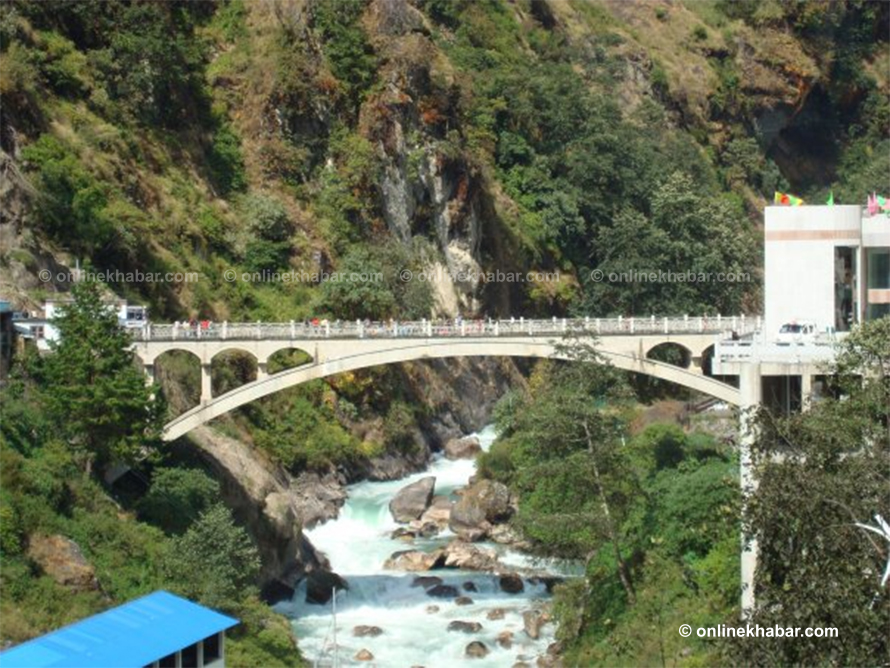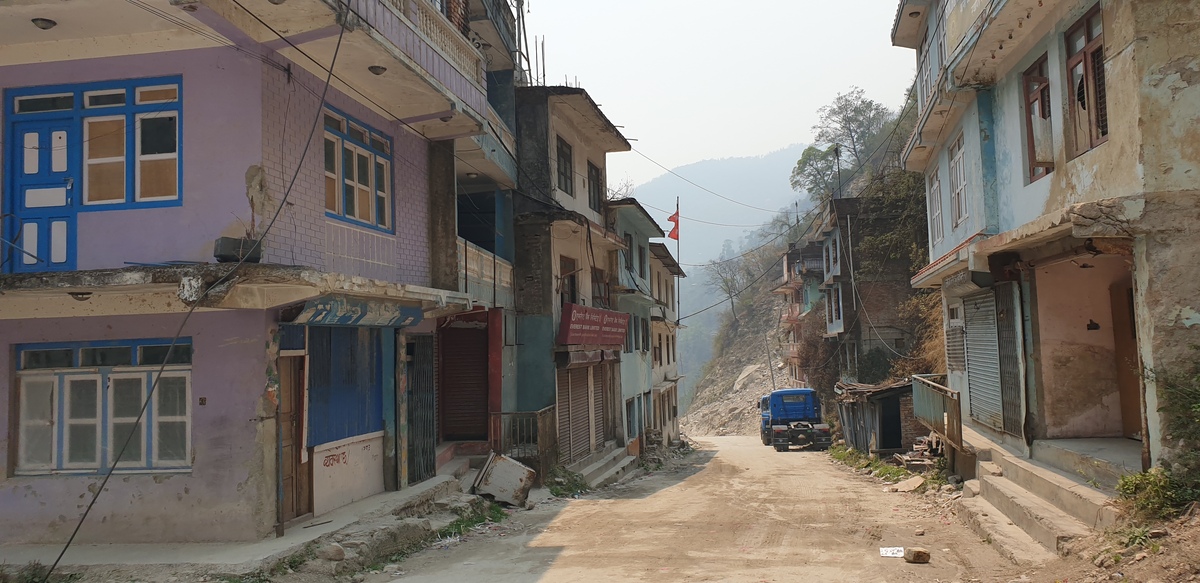
With a yellow tiger-print red furry blanket in one hand and a duffel bag full of Chinese goods in the other, my sole childhood memory of Tatopani was the colourful return of neighbours from their Taopani-Khasa trip.
In an impulsive decision triggered by the news of the border reopening, I set off on my own Tatopani-Kasa trip. Surprisingly, I had entered a desolate ghost town full of vacant, locked, and demolished houses, my glorious childhood idea of Tatopani-Khasa bazaar shattered by harsh reality.
Just 112 km from Kathmandu, Nepal connects with China by a Miteri bridge at Liping. The history of Tatopani-Khasa Bazaar dates back to when salt, the “white gold” of the Himalayas, was as valuable as currency.
In Nepal, salt goes beyond taste—it used to be the backbone of the Himalayan economy and people’s lives. Life in Tatopani-Khasa revolved from the rhythmic arrival and departure of caravans to trucks full of containers. What started as swapping salt for grains turned into a major trade route.
Along the bustling Kali Gandaki River, Nepal’s major import-export hub buzzes with trade, playing a big role in the country’s pulse. But the scenario isn’t the same as it used to be.
Current picture of Tatopani-Khasa Bazaar

The earthquakes of April and May 2015 struck devastation in Sindhupalchok, destroying nearly every house and killing approximately 4,000 people, making it one of the locations with the most casualties. Following the big earthquake in 2015 and a landslide in 2016, the border with China closed leaving Tatopani and nearby places like Liping Bazaar empty and abandoned.
Despite the challenges, the spirit of Tatopani-Khasa Bazar persists. The locals, like Gurmi Sherpa and his wife Kani, who run a shop in Kodari, dream of the bazaar’s revival. They recently bought their new shop for 70 thousand rupees. Their life transformed from trading on the streets before the earthquake to facing eight-year unemployment.
“How can we sustain in Kathmandu? We don’t have income, house, or property there. For six months, we went to Kathmandu. We could not get any jobs there, and my sons had their own families to feed. We didn’t want to be a burden. Here we have people who will help us in bad times. And I have to make offerings in the Gumba three times a year,” says Gurmi.
This feeling is common among those who have returned to their village after struggling in big cities like Kathmandu.
Ramey Lama, 71 years old, had worked at the Tatopani ticket desk for 17 years. He shared stories of the days when the bazaar was a lively hub, a melting pot of culture and commerce between Nepal and China. His voice held a mixture of sorrow and nostalgia as he recounted the vibrant past, now only a memory. He portrayed a picture of a bustling community now hushed by the earthquake’s effects.
Tatopani, renowned for its therapeutic hot springs—a natural wonder that has attracted visitors for generations—faced another setback when the springs were destroyed by a flood in 2016. “The community, guided by the rural municipality’s efforts, led to the reconstruction of the hot springs,” says Ramey.
Lakpa Dolma, a 38-year-old, spoke about significant shifts in economic conditions after the border reopening. Still, 90 per cent of the products are now sourced from Kathmandu, even though more profitable Chinese goods make up only a minor portion. She pointed out tourism as a remedy for economic recovery. Thousands of Indian Hindu pilgrims used to travel to the holy Kailash-Mansarovar region in Tibet every year through the Tatopani border point of Nepal with China before the earthquake.
“People come to Tatopani, particularly on Saturdays. There used to be a huge number of tourists during the month of Kartik and Chitra,” she explained. Her words highlight Tatopani-Khasa’s lasting attraction, not only as a commerce hub but also as a cultural and environmental site worth seeing. While pointing out what used to be a thriving shop, she said, “The 2015 earthquakes had not just shattered buildings but also the dreams and livelihoods of many.”
Government’s negligence
The role of government and Chinese aid in reconstruction shows a complicated dynamic of dependency and control. “The Nepal government does nothing for us; we are in the hands of the Chinese,” Gurmi says, claiming China’s substantial influence in the region, which ranges from providing aid to regulating the reopening of the border. While the assistance has been crucial in restoring the infrastructure, Gurmi Sherpa’s experiences highlight the issues of corruption and inefficiency that usually surround such aid.
Before the earthquake, China allowed one-day passes to the neighbouring Khasa (Zhangmu) market and back. A large number of Nepali had established their businesses in the neighbouring town. Since the earthquake struck the border region, the Chinese side shifted the whole Khasa market to a new location. “There is no human settlement along the border right now besides government officials. The only structure built by the Chinese near the border is their customs office,” said Gurmi.
“Hundreds of trucks used to travel through this road before the earthquake,” Gurmi said, creating a picture of a time when Tatopani-Khasa was more than simply an abandoned border town.
“The streets used to be full of jholey byapari (street vendors), all the way from Khadi chaur and Barabisey,” he recalled, bringing up memories of a bustling marketplace where each vendor’s shout and each customer’s bargain contributed to the rhythm of daily life.
“A lot of smuggling has happened here, from gold to sandalwood to statues and idols,” he explained, shedding light on the opposite market that coexisted with regular trade.
As I left Tatopani-Khasa, the sharp contrast between the bustling market of the past and its current state lingered in my thoughts. Gurmi Sherpa, Lakpa Dolma, and Ramey Lama’s stories are more than just tales of tragedy and transformation; they are testaments to the human spirit’s dedication and adaptation.
Despite the huge misfortune, the people of Tatopani-Kodari maintain hope, a testament to their enduring resilience and optimism for a future filled with the vibrant hustle of trade and life.



















